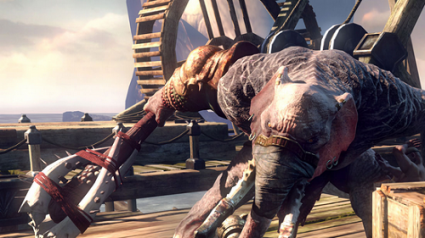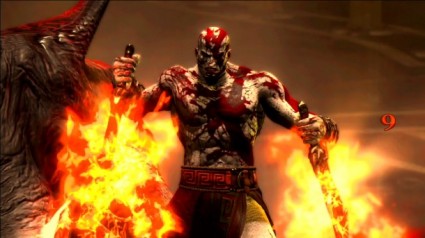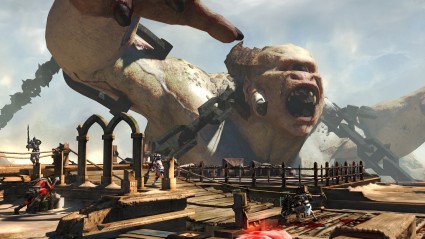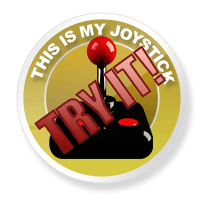Reviews
God of War: Ascension
May 7, 2013, Author: Andy Buick
Ah, God of War; home of murderous rage, quite literally eye-popping and gut-wrenching finishing moves, and the odd slightly inappropriate mini-game. Since the release of God of War on the PS2 back in 2005, the series has consistently set the benchmark for action games with its epic story of deicidal revenge, brilliant fighting mechanics and stunning graphics.
Though having finished off pretty much everyone in Greek mythology, can God of War: Ascension continue to lead the way, or is this another story of diminished returns with a sequel too far?Revenge is a dish best served with a side order of guts
In the fourth home console outing for Kratos, God of War: Ascension, we turn back the clock to not long after Ares has betrayed him. The Furies have imprisoned Kratos for breaking his blood oath to Ares, and we pick up with one of them, Megaera, torturing him.
This is a Kratos still raw from the betrayal that saw him kill his own wife and child, and as an earlier tale in his story we don’t have quite the same level of insane anger that constituted Kratos’ approach to pretty much anyone he encountered in the previous games, whether they were innocent or bad. Here we see his more human side and for me at least that was a welcome change.
We see him hold the hand of someone who’s dying, and some genuine regret that he has to kill someone else. If this had been one of the previous games, he probably would’ve chopped the hand off the first person in case it came in handy later (no pun intended!), and stabbed the latter about a hundred times just to be absolutely sure they were dead, dropping a mountain on their head for good measure.
Now while I welcome this change, and found that it grounds the Angriest Man in Gamingtm a little more in reality, let’s be honest; we don’t play God of War for a nice bit of hand-holding or a dose of reality, we play it for spectacle. We want puzzles in areas the size of skyscrapers, finishing moves that are at once awesome to behold and also slightly threatening to the food you ate a short time ago, and we want these finishing moves to happen on well-known monsters and characters from Greek mythology, all wrapped up in bleeding-edge graphics and a slick combat system. So what really matters is whether Ascension delivers these.
In the beginning, was the word… and the word was ARRRRGGGGH!
The opening in God of War games is always a big deal (the Hydra in 1, the Colossus in 2, Poseidon on the back of Gaea in 3), so there had to be a massive opening battle. The sheer scale of the opening sequence of GOW3 had me fearing what they could do here. Since this is a prequel, we know who Kratos has killed in later games so there didn’t seem a whole lot of Greek mythology left!
While they have still managed an opening which is impressively epic in scale, somehow it just doesn’t have the same wow factor. On this occasion, you fight one of the Furies while escaping their prison, which was built using a massive creature called Aegaeon the Hecatonchires. This means that the prison actually moves at times while you’re fighting your way through it, which is suitably impressive; but at the same time you can’t help but feel that you’ve been through this before and it’s been done better.
By the nature of the story, everything is scaled back from God of War 3 (there are no Gods at all in this game) but there are still scenes that are absolutely massive in scale. In particular a puzzle sequence involving three giant mechanical snakes impressed me, but it just feels a little too familiar after several games, which took the sheen off what otherwise would have been fairly jaw-dropping.
Then we come to the characters and monsters encountered. There are some familiar monsters from previous games such as centaurs, gorgons (intensely annoying to fight in this game), and satyrs, but also plenty of new monsters. Yet here I had a problem with what has been done, not so much down to the fights themselves, but that I don’t recall there being too many elephant monsters in Greek mythology, for a start.

Elephant men: well-known in Greek mythology
Gameplay is an evolution of that in previous games, although in some ways I couldn’t help but feel this evolution was not for the better. Kratos still fights with the Blades of Chaos as his primary weapons, but there are some subtle changes here. A grapple move has been brought to the fore, with a press of R1 flinging out one of the blades to snare a foe. You can then keep hold of this foe while continuing to fight with your standard mix of light and heavy attacks mapped to square and triangle, or you can throw them using circle.
The other noticeable change is to how you parry. Previously this was a tap of L1, timed to meet an attack. Now though, you have to hit L1 and X, which for me was a real step in the wrong direction. In fact I found parry much more difficult to use than in previous games, where it had been intuitive and lent a real flow to fighting. Here, particularly when playing on hard as I was, I found it difficult to time correctly to the point where trying to use it ended up being almost counter-intuitive, and I ended up relying on evading and simply blocking instead.
When you’re being mobbed by a large number of enemies, however, some of which can break your block with certain attacks, evading and blocking become less effective. In the end I found that on a number of occasions I just had to rely on the R1 capture, followed by a throw, to both keep foes at bay, as the act of doing this seems to stop you from being hurt during the animation. I’m willing to accept that my own abilities at the game might have been part of the issue here, but most importantly fighting just didn’t flow as well as it did in previous games because of these changes.
Rather than having other upgradeable weapons to swap in and out, this time we have world weapons that can be picked up from the world as you go through it with a press of R1. These aren’t upgradeable and can be discarded with a more powerful attack. These allow you to mix things up a little, and the javelin in particular is useful for ranged attacks, for example. I did miss the character of some of the sub-weapons from previous games (the Nemean Cestus in particular were very cool), but these do prove useful throughout, especially on harder difficulty levels.
Another minor change is to the way some finishing sequences are handled. Many are still timed button-press QTEs, including during boss battles; but some are more free-form, expecting you to attack as normal and then dodge out of the way of attacks, attack some more, and then a finisher is triggered. This is a welcome change from pressing the right button in time (which can be somewhat annoying), while still offering plenty of crazy kills, which seem to largely be centered on cutting heads open this time round.
Beyond standard attacks, there’s a change of approach to magic as well. This time you can imbue the Blades of Chaos with elements aligned to different Gods, such as lightning with Zeus, eventually having four elements mapped to the directional pad. You can upgrade each element to gain more attacks and open up magic attacks, but I found that I ended up largely using the fire element, and pretty much ignored the water/ice element completely throughout the game. There’s no obvious reason to switch between them all that much, and I found the fire magic attack to be far more effective than most of the others (although the lightning magic attack is worth unleashing sometimes as well).
You also pick up some handy artifacts along the way, which are used for puzzle-solving but also come with a use while fighting. One of these in particular, an amulet that allows you to heal or decay your surroundings, leads to some fairly fiendish puzzles which provide an interesting change from previous games. As with previous games in the series, you pick up red orbs along the way to upgrade all of these as well as the blades.

Angry scowl? Check. Oodles of blood? Check. Big flaming blades about to dish out a world of pain? Definitely check!
At this point it is worth mentioning that a section towards the end of the game, called the Trials of Archimedes, is probably the hardest section out of any of the God of War games. By hardest, I mean punishingly so. Sony Santa Monica actually ended up releasing a patch to balance this section out slightly, it is so hard, and even with the patch I can say that it is an extremely stern challenge, which almost caused me to drop the difficulty. Thankfully I did get through it after a good 10 to 15 attempts, but it ended up being a slog which was no real fun at all, even if I did get a sense of satisfaction having beaten it. Or maybe that was more relief…
Aside from the aforementioned opening sequence, I have to say that the boss battles are a little disappointing as well, with none really standing out. In fact, some of these fights lack imagination to the point that re-spawning lesser enemies are used to make the fight tougher, an approach which I have to say has never sat well with me.
Is that his brain?!
GOW games have always been right at the highest level where graphics are concerned, with GOW1 and GOW2 being arguably the best-looking PS2 games, and GOW3 setting the bar for what the PS3 could achieve when it came out (in particular the fight with Poseidon at the start of the game, but also the fight with Chronos is particularly impressive).
I’m happy to report that in this respect GOW: Ascension is far from a letdown. It’s an absolutely stunning game from start to finish, and even if it can’t quite match the spectacle of the third game, it still crams in some huge areas and incredible puzzles of a gigantic nature which only fail to provide a real wow moment because of what we’ve seen before. No other game of this type does scale as well. Kratos’ character model is also worthy of mention; you can see his pores and sweat in close-ups, and the general detail is excellent. It’s safe to say that just as with GOW3, this is one of the best-looking games on PS3.
Of course, it uses this graphic technology to show off innards, brains, and other bits that should be on the inside rather than the outside as well, not to mention buckets of blood (there’s a trophy for covering Kratos in 500 buckets of blood which you will get easily during the course of the game), so if you don’t like gore then you may actually wish the graphics are worse than they are!
The hills are alive, with the sound of murder
The sound in GOW games has always been high quality too, and as such there’s nothing new to report here; although credit must go to the voice-acting, particularly for Kratos where that extra human dimension has been added quite successfully. The Furies are a little on the hammy side, being, perhaps unsurprisingly, full of fury and not a lot else. Other characters are more rounded though, and are handled with suitable gravitas.
Sound effects are really just re-used from previous games, but they worked perfectly then and the same applies now. The only note I would like to add is that the sound did cut out on several occasions during my playthrough, each time for a couple of seconds. This has now been patched, however.

Multiplayer: 4v4 battles include secondary goals such as slaying a giant cyclops
Group hug! Hey, is that a spear? Oh, it is…
I have to admit that when I first heard multiplayer was going to be added to the new God of War, I was extremely dubious. I thought it may detract from the single-player game, making it shorter (wrong; it took me over 11 hours to play through on hard), and be rubbish (also wrong!).
I’m also pleasantly surprised to be able to report that Santa Monica studio have done a bang up job of the multiplayer. When you first load multiplayer there’s a clever link to the single-player game, which sees your online hero being brought before the four Gods represented by the different elements in the main game. You select one, choosing whichever attributes appeal to you. I went with Hades.
There are no great surprises in terms of game modes here (deathmatch, team deathmatch, capture the flag, and a domination mode), but the levels are in the main designed extremely well, often changing during the course of a bout with sections moving or disappearing. In the case of the larger 4v4 levels, there is an additional way to gain XP, whether it be destroying a statue, or killing Polyphemus, a particularly huge cyclops.
As is commonplace in most multiplayer games now, you can level up your character as you gain XP, and this happens quickly enough to keep you engaged. The good news for those not all that adept at fighting is that there are other means of gaining XP as well, from simply opening a chest of red orbs, to capturing the flag, or taking control of an altar in Team Favour of the Gods.
One gripe I have here though, is that the way in which you upgrade or swap armour and weapons is fairly unwieldy, and I found that after levelling up I never had enough time to see whether I wanted to make a change to something new I’d unlocked before the next round started up. On a couple of occasions I simply had to exit back to the lobby to be able to make some changes. That’s a small gripe really though, in what is a surprisingly engaging and enjoyable online experience.
Good God!
If you’re a fan of the series then you’ve probably bought God of War: Ascension already, but if you haven’t then you’ll find plenty to enjoy here without any doubt. Even if you’re new to the series there’s an extremely well-polished and enjoyable game to be found here, but unfortunately an element of flow to the fighting has been lost and that is such a key part of the experience that it really does detract slightly from the fun. Over-familiarity at this point is also starting to take off the admittedly still impressive sheen as well.
For now, this still serves as a very good action game with a surprisingly decent multiplayer element to it, but here’s hoping that when the next sequel inevitably appears (presumably on PS4), some more significant changes occur to really freshen the series up.
Platforms: PS3 | Tagged action, Beat em up, God of War, God of War: Ascension, gods, Kratos, Platformer, PS2, PS3



